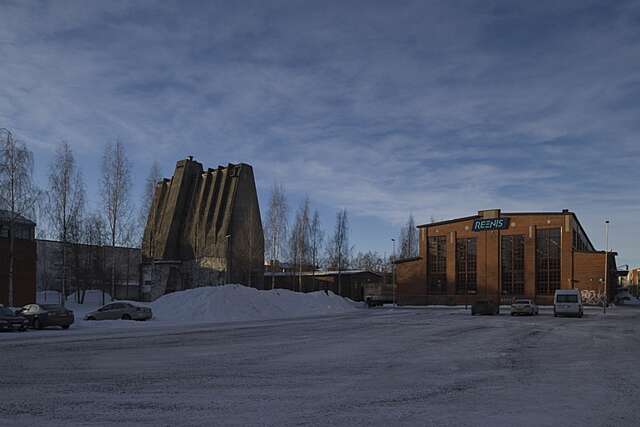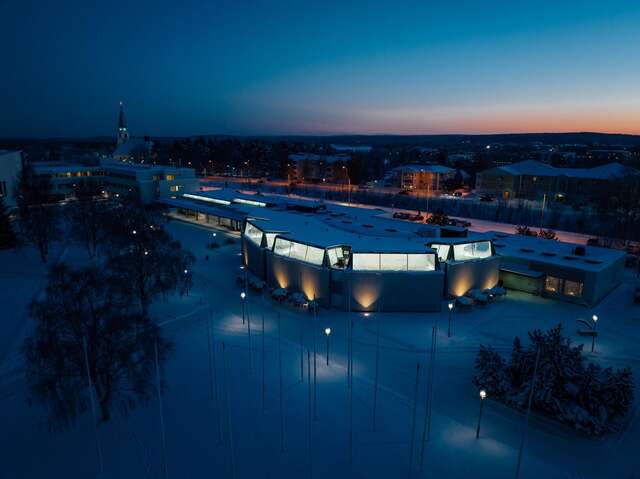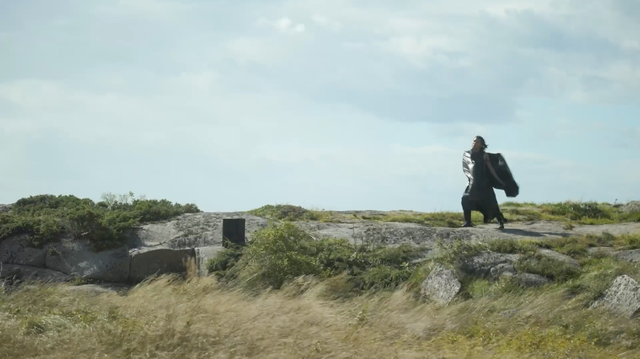On behalf of neighbourhood shopping centres
Paavo Foley
Many shopping centres from the mid-1900s have been demolished or allowed to fall into disrepair. Visual artist Salla Valle and artist-curator Miina Pohjolainen want to spark a debate about the state of these shopping malls. Their Instagram account "Ostaritutkimuksia" invites people to see old shopping centres with new eyes.
We meet with visual artist Salla Valle in front of the North Vuosaari shopping centre. It's our fist stop on a tour of East-Helsinki's shopping centres. Together with artist-curator Miina Pohjolainen, Valle runs an Instagram account called Ostaritutkimuksia. They set up the account showcasing old shopping centres around the suburbs of Helsinki as part of a wider project that also included a blog, an art exhibition and a book.
The interest in exploring shopping centres started after Valle moved to Laajasalo in eastern Helsinki, where a local shopping centre was about to be demolished. Seeing the building in a state of disrepair sparked an interest – who was using the premises and for what purposes? Together with Pohjolainen, she decided to start documenting Helsinki's old shopping centres and what happens in them day-to-day.
The duo soon realised that the meandering, low-rise shopping centres that stretch out in the heart of a neighbourhood were a vanishing part of our cultural heritage. Old shopping centres are being demolished as shops and services are concentrated in giant commercial complexes. "Experiencing, exploring and documenting these spaces had to be done now, not in the future, by which time it would be too late," Valle stresses.
Change has left a dormant shopping centre behind
On a Monday afternoon, it is quiet around the North Vuosaari shopping centre. Designed by architect Lauri Silvennoinen and completed in 1965, the commercial building looks like a typical 1960s suburban shopping mall. Empty storefronts and crumbling walls are a sign of the building's age and that its best days are behind it. It doesn't help that a new commercial building has risen next to it; a building quite similar to the old one but much more modern, and it has attracted the supermarket formerly located in the shopping centre to move in.
We take a tour around the shopping centre. What catches one's eye is that the commercial premises are all at street level and there is plenty of window space. "The shopping centre kind of spills out onto the street," says Valle. The premises are indeed much more appealing than today's commercial centres. Valle also suggests that in a new residential district, a shopping centre of this kind would no longer be built, but instead, a few commercial spaces would be incorporated on the ground floor of a block of flats.
The entire North Vuosaari residential area was planned as a whole, with the shopping centre at its heart as a meeting place where all the necessary services were found. The current state of the shopping centre is a source of much thought. Society has changed considerably since the 1960s, and along the course, people's consumption habits have changed as well. Shopping is done online or in big supermarkets further away, easily accessible by car or public transport. The supermarket is precisely in between the unnecessary and the necessary. It feels as if the building no longer belongs anywhere.
New residents and entrepreneurs breathe life into an old shopping centre
After North Vuosaari, we move on to the Puhos shopping centre in Puotinharju. Designed by architect Erkki Karvinen, completed in the 1960s and expanded in the 1980s, the shopping centre is full of life. Almost every commercial space is in use, and people are bustling through the building.
Until recently, Puhos was also under threat of demolition, but the latest draft plan proposes to renovate the historically valuable A section. The 1980s additions, on the other hand, are still likely to be demolished. The commercial appeal of Puhos waned significantly in the 1990s when the giant commercial centre Itis, built next to it and extended several times, took customers away. In the 2000s, however, business picked up again as new shops were set up by entrepreneurs with different ethnic backgrounds.
Looking at the state of the building, it is easy to see that the shopping centre is starting to deteriorate, but it still serves its ultimate purpose: as the heart of the local community.
For many entrepreneurs, demolishing the newer parts of Puhos to make way for new high-rise buildings would mean moving into temporary premises or finding a new commercial space altogether. On the other hand, the renovation of the original Part A will allow the place, history and culture of Puhos to be preserved. "So the situation in Puhos is not quite as bleak as in many other shopping centres," says Valle.
An active residents' association can have influence
We walk from Puhos across the street to Itis, where we jump on the metro. The transition from Puhos to Itis feels like a journey through time, from the 1960s to the present. The contemporary architecture, international chain stores and flashing billboards of Itis are from a different universe than Puhos.
A metro ride takes us to Kulosaari. The surroundings of the local shopping centre are bustling as the school across the street is closing for the day and parents are picking up their children. The Kulosaari shopping centre, completed in 1960, was also designed by architect Erkki Karvinen.
The building is in fair condition and looks vibrant, although it is showing some signs of decay. On the other hand, the surrounding buildings, such as the primary school, which was renovated in 2013, and the blocks of flats across the street, make the shopping centre look old, as if it were from another time and place.
The commercial spaces include a singing school, an Asian restaurant and a grocery shop. The services offered by the three shopping centres we visited are almost entirely different, but they seem to meet the needs of the population living in the area.
The fate of Kulosaari Shopping Centre may not look as bleak as that of Vuosaari. The leading daily, Helsingin Sanomat, reported this spring on efforts to save the shopping centre, and it seems that it is not going to disappear. This is due, in particular, to the active residents' association, which has managed to lobby against the shopping centre's demolition. Here, the residents' association has been able to make its voice better heard than its counterpart in Vuosaari, for example. Our guide, Salla Valle, wonders whether the fact that the residents of the Kulosaari district are financially better off and socially well positioned plays a role.
Today's huge commercial centres are not a shared space
According to visual artist Salla Valle, the renovation of old shopping centres should start as soon as possible if they are to be saved. After renovation, they could be allowed to fill up with services and activities that will organically develop in them. You can already see this happening in Puhos: prayer rooms and ethnic food shops serve the needs of the people using the shopping centre. But Valle is cautious about utopias, and the future is unknown. However, she hopes that people will wake up to the need to defend the existence of the old shopping centres on a wider scale.
The contemporary indoor shopping centres are privately owned spaces where the maintenance of order is often a service bought from a private security company. Security guards in private spaces have broader powers to remove unwanted people and activities than in street areas. Political activities, like election campaigning, are also banned in many commercial premises. "These commercial centres are taking over the city, so I think it would be reasonable for the whole spectrum of the city's activities to be visible in them," says Valle.
For example, the existence of publicly run social support facilities, such as the Vuosaari residential house located in the North Vuosaari shopping centre, is threatened if their premises are demolished. Valle has reservations about locating these types of services in privately owned commercial centres, as taxpayers' money would then be transferred to real estate enterprises in the form of rental income.
Valle urges people to visit these kinds of traditional shopping centres and experience their atmosphere, as they may soon be gone. According to her, it is also an interesting way to see the city in a new way and to learn about local cultures.


